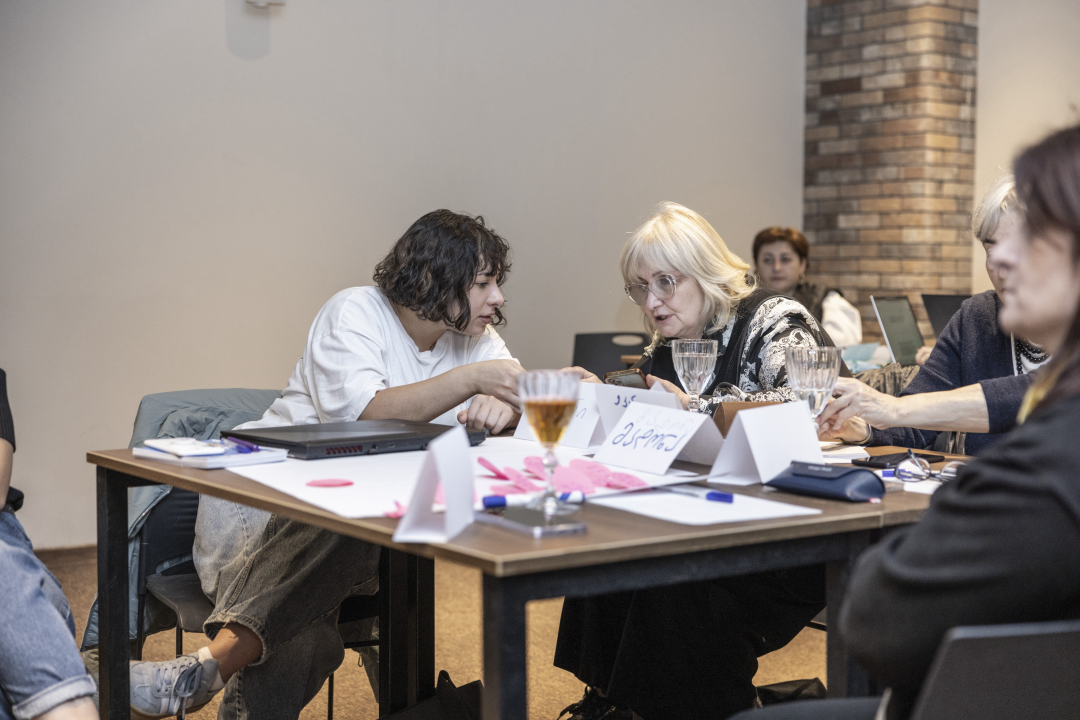Disclaimer:
Please be aware that the content herein has not been peer reviewed. It consists of personal reflections, insights, and learnings of the contributor(s). It may not be exhaustive, nor does it aim to be authoritative knowledge.
Overview
Prepared by (Name of the experimenter)
Georgia Accelerator Lab
On date (Day/Month/Year)
June - Dec. 2024
What action learning plan is this activity related to?
Georgia Accelerator Lab learning plan
Design
What is the specific learning intent of the activity? Why is it important to do this experiment?
Globally, e-waste is escalating, with 62 million tons produced in 2022 and expected to reach 82 million tons by 2030, mostly unrecycled. In Georgia, e-waste management is established as a legislative priority, but local implementation remains challenging, underscoring the urgent need for effective strategies to address this issue.
To bridge the circularity agenda with recovery efforts for conflict-affected vulnerable communities, the Accelerator Lab in Georgia is aligning national e-waste policy implementation in partnership with EPR Association "Wasteless" with grassroots action research and ecosystem building, in collaboration with the private sector, in Zugdidi, Georgia.
The learning intent of the activity included:
- To see if innovative approaches could be leveraged for contributing to policy implementation through community action;
- To explore how curating and leveraging local ecosystems not directly involved in e-waste management could contribute to building sustainable e-waste management practices at the local level in Zugdidi.
What is your hypothesis? IF... THEN....
We hypothesized that by increasing the convenience and accessibility of e-waste disposal services, leveraging social norms through informative campaigns and engagement of schools as change agents, we would see an increase in the proper disposal and collection of e-waste across Zugdidi.
Does the activity use a control group for comparison?
Yes, a different group entirely, Yes, the same group but before the intervention
Describe which actions, with whom, where, when will you (or did you) take to test your hypothesis:
We initiated our collective intelligence exercise by conducting baseline user research, followed by a series of community consultations, starting with a design workshop for local stakeholders. The user research involved a review of the EPR legislation, and of international and local initiatives including those carried out by the global Accelerator Lab network. We also conducted internal consultations with UNDP teams and over 20 interviews with key stakeholders in Tbilisi and Zugdidi. As for the workshop, it was co-organised by the Waste Management/EPR organisation “Wasteless”, an association specialising in electronic waste management. The workshop was attended by representatives of the local CSOs, academia, youth organisation, and media.
We partnered with local behavioural experts (BISC Partners) to co-design and test solutions addressing the key findings of the workshop and user research. Our collaboration with BISC Partners kicked off with an Initiation Workshop, organised in Zugdidi. The purpose of the workshop was for the experts to gauge the local stakeholders' experiences related to the target behaviour (sustainable e-waste disposal), agree on the segmentation of the target population for further Behaviour Drivers analysis, and start assessing potential intervention opportunities collaboratively.
Following the workshop and guided by BISC, AccLab conducted multiple in-depth interviews with key population segments (youth, housewives, waste management workers, tech repair companies and individuals, and tech industry professionals) to capture a range of behaviours and motivations for the research. BISC then analysed the in-depth interviews using two methods: (1) Behavioural Influence Framework: analysing the underlying motivations and deterrents shaping the behaviour of Zugdidi residents towards e-waste; and (2) “Value Goals”: exploring the functional, emotional and social drivers that could encourage them to get involved in e-waste collection and proper disposal.
The behaviour mapping process drew the contours of potential entry points for our experiment. To test the ground for our ideas, we held one final consultation (Ideation Workshop) with the local stakeholders. There, BISC presented the findings of the in-depth interviews and behaviour mapping and facilitated groupwork on possible interventions using BIT EAST framework. The result was crowdsourced intervention concepts selected based on impact and feasibility of implementation.
Once the community consultations and subsequent behaviour mapping were finished, AccLab and BISC collaborated on designing a BI-informed experiment. The study comprised of 3 experiments: (1) increasing visibility and convenience of e-waste collection infrastructure in a retail setting; (2) testing the role of messaging strategies in residential contexts (targeting vulnerable IDP communities); and (3) leveraging schools as hubs for social and educational influence, aiming to embed long-term, community-wide behavioural changes. In conjunction with the experiments, an observation phase was planned to document real-world e-waste disposal behaviours and motivations through qualitative observations, self-reported data, and quantitative disposal metrics in public settings, focusing on a local FabLab and library to capture diverse participant profiles. Together, these experiments were designed to address both the structural barriers (e.g., accessibility and infrastructure) and socio-psychological dynamics (e.g., norms, awareness, and messaging), bridging the intention-action gap – a common phenomenon where individuals’ stated intentions to engage in sustainable behaviours fail to translate into actions. The monitoring phase lasted 3 weeks at the end of which the quantitative and qualitative data were analysed to reveal the unique challenges and opportunities in e-waste collection in Zugdidi.
If you worked with partners, please choose what sector they belong to (select all that apply)
Civil Society, Academia, Private Sector, Government (& related), United Nations
What is the total estimated monetary resources needed for this experiment?
Between 10,000- and 20,000 USD
Please upload any supporting images or visuals for this experiment.
Please upload any supporting links
Results
Was the original hypothesis (If.. then) proven or disproven? In which way do the results support the original hypothesis or not?
The study explored the effectiveness of behavioural interventions and observational strategies in promoting e-waste disposal in Zugdidi, building on recommendations to improve accessibility and leverage social norms through targeted campaigns, with three experiments and an observational phase examining how visibility, messaging, education, and context influence engagement.
The first experiment showed that increasing visibility and accessibility alone did not significantly change behaviour, with no e-waste contributions during the intervention phase, highlighting the importance of contextual factors like a depleted e-waste pool and the lack of financial incentives.
The second experiment showed that messaging strategies, particularly environment-focused messaging, significantly increased e-waste disposal rates, while site-specific challenges like theft and vandalism highlighted the importance of secure infrastructure in promoting engagement.
The third experiment found that while school-based educational programs slightly increased the diversity of e-waste collected, overall disposal rates were similar to the control group, suggesting that longer-term efforts and improved logistics are needed for sustained behavioural change.
The observational phase revealed higher e-waste engagement at the Zugdidi Library, driven by social influence and visibility, while the local FabLab had lower participation due to limited foot traffic, highlighting the importance of location-specific factors.
Overall, the study provided valuable insights into the behavioural and contextual factors influencing e-waste disposal in Zugdidi. While each experiment and observation phase revealed unique challenges and opportunities, the overarching findings underscore the importance of integrating behavioural, structural, and educational strategies for fostering sustainable waste management practices. By addressing logistical barriers, extending interventions, and leveraging community engagement, future initiatives can build on these insights to achieve broader and more sustained participation in e-waste disposal. These lessons hold relevance not only for Zugdidi but also for other communities seeking to improve e-waste management systems.
What are the most important learning outcomes of the experiment? Are any changes recommended?
We learned that understanding the user’s needs through listening and building trust are essential for fostering the empathy required to gain user traction. The community consultations (including key stakeholder surveys, three workshops in Zugdidi, and in-depth interviews) helped us gauge Zugdidi residents’ perceptions and behaviours regarding e-waste collection and disposal. However, even more importantly, practicing active listening allowed us to genuinely empathise with our target audience’s perspective, build local social capital, earn the trust of our partners, and engage all stakeholders with greater intention, enthusiasm, and a shared sense of purpose. The true rewards of listening and building social capital in Zugdidi became evident when local partners took the initiative and proposed ideas for the project’s future. We realised that, regardless of the project timeline, such interventions should focus on continued engagement with community ecosystems for ownership and sustainability.
We also learned that the initial assumptions do not always hold true and that it is the unexpected findings of action research that often provide the most valuable insights. Initially, we hypothesized that most e-waste would be collected at schools because (1) a large concentration of youth are present in schools, (2) community consultations indicated that students are particularly receptive to new ideas and behavioural changes, and (3) we had held an informational session on e-waste at one of the schools. The experiment, however, revealed that most e-waste was collected at the city library, whose director turned out to be a community leader, spreading the word not only among the library’s youth and adult visitors but also within his network of co-workers, friends, and family. While our initial assumptions were not entirely disproven - schools did, in fact, collect a significant amount of e-waste - we learned not to underestimate the power of civic leaders and the influence they have in mobilizing broader community support and participation.
Learning
What were the main obstacles and challenges you encountered during this activity? What advise would you give colleagues trying to replicate this experimental activity?
We learned that the ideal scenario is never the real scenario and that innovation is a continuous journey of taking risks, confronting limitations, adapting to barriers, making pivots, iterating, and learning. We encountered several obstacles throughout our e-waste experiment:
(1) One challenge we faced was the timing of our project coinciding with the months leading up to and following the general elections, which likely diverted the focus of Zugdidi residents away from our initiative. To address this, we had to plan with flexibility in mind—ensuring that community consultations were completed before the elections to avoid overlapping with critical phases. We also accelerated key milestones, completing the segmentation, in-depth interviews, and behaviour mapping processes within just a few weeks. Last but not least, leveraging the combination of CO institutional memory in innovation and novel knowledge brought by AccLab's new members played a pivotal role in navigating the uncertainties involved.
(2) We also discovered that some partners were more challenging to bring on board than others, requiring us to rely heavily on creative problem-solving to uncover hidden opportunities and find more “unusual suspects”!
(3) Despite leadership support, we encountered the need to balance research needs against timeline and budgetary constraints, which were further exacerbated by lengthy operational processes for procurement of technical services. Investing in Lab's newcomers' training in operational skills proved essential in this regard.
Overall, it was the vulnerability brought on by these obstacles that truly fuelled our learning. We embraced risks, adapted to challenges, learned from our setbacks, and approached problems with creative solutions, constantly seeking alternative paths to drive our project forward. In other words, we really learned to truly trust the process, embracing both its ups and downs.


 11Sustainable cities and communities
11Sustainable cities and communities 12Responsible consumption and production
12Responsible consumption and production 13Climate action
13Climate action

Comments
Log in to add a comment or reply.